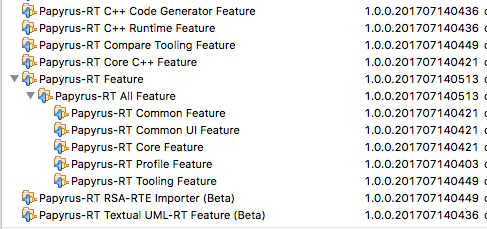Hello everyone. While trying the updated version of the Oomph setup in preparation for the 1.0 release I noticed that the structure of features in the "Installation Details" dialog is a bit odd:
First, there is a "Papyrus-RT Feature" which includes only "Papyrus-RT All Feature" (which could be seen as grammatically awkward) and it does *not* include *all* features. Codegen, C++, Textual, Compare and the RSA-RTE importer are all outside.
Is this the way it's supposed to be?
Charles tells me that some of these features, like Codegen, Runtime and C++ are supposed to be optional, and not part of the "core" or "base" (Profile+Core+Common+Tooling). That's fine, but 1) what about "Compare"? Is it a "core" feature? How about the importer?
Why have two levels of nesting under "Papyrus-RT Feature"? That seems very awkward. I would suggest one of four options:
Option 1) Only one top-level Papyrus-RT Feature called "Papyrus-RT Complete Feature" (or something like that) with two sub-features "Papyrus-RT Base" and "Papyrus-RT Extras":
Complete/
├── Base
│ ├── Common
│ ├── Core
│ ├── Profile
│ └── Tooling
└── Extras
├── C++
├── Codegen
├── Compare
├── Importer
Option 2) Two separate top-level features "Papyrus-RT Base" and "Papyrus-RT Extras":
Base/
├── Common
├── Core
├── Profile
└── Tooling
Extras/
├── C++
├── Codegen
├── Compare
├── Importer
├── Textual
└── Runtime
Option 3) Like option 1, but "extras" are not bundled in one feature:
Complete/
├── Base
│ ├── Common
│ ├── Core
│ ├── Profile
│ └── Tooling
├── C++
├── Codegen
├── Compare
├── Importer
├── Textual
└── Runtime
Option 4) Similar to the status-quo but removing the extra level of nesting:
Base/
├── Common
├── Core
├── Profile
└── Tooling
C++
Codegen
Compare
Importer
Textual
Runtime
Option 5) The status-quo (with a better name for the "All" Feature):
Papyrus-RT/
└── Base
├── Common
├── Core
├── Profile
└── Tooling
C++
Codegen
Compare
Importer
Textual
Runtime
Any thoughts or opinions?
--
Ernesto Posse
Zeligsoft

